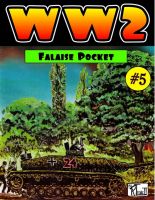
It could be said that the Battle of the Falaise Pocket was actually the culmination of many preceding confrontations: Breakout from Normandy, Cherbourg Peninsula, Caen, the Orne River and the Breakout into Brittany. The German generals and the Allied commanders together could never have guessed the outcome of this epic battle, a turning point of World War II. The Allied encirclement of several German armies occurred so quickly that the Wehrmacht was caught without a strategy to cope, nor with any reserves to break open the relatively weak Allied ring. The American, British and Canadian forces were also completely surprised by the magnitude of their success; they were unprepared to exploit it. Perhaps one man, U.S. General Patton, had an idea how to exploit this phenomenal achievement—had Supreme Commander General Eisenhower given him a free hand. With their complete dominance of the air, the Allied armies could nave rapidly destroyed the German forces in the pocket and advanced nearly unchallenged all the way to Germany. But the Allied commanders followed military success with extreme caution. They elected to reduce the pocket gradually before moving forward, thus passing up a golden opportunity to end the War in 1944.
The Battle of the Falaise Pocket did seal the fate of the German Anny in the West and left its remains lying prostrate, strung out from Norway to Italy and Greece; without any kind of “anchor point” for a cohesive defense. As a result, it could certainly be argued that this was the decisive battle of World War II.








































